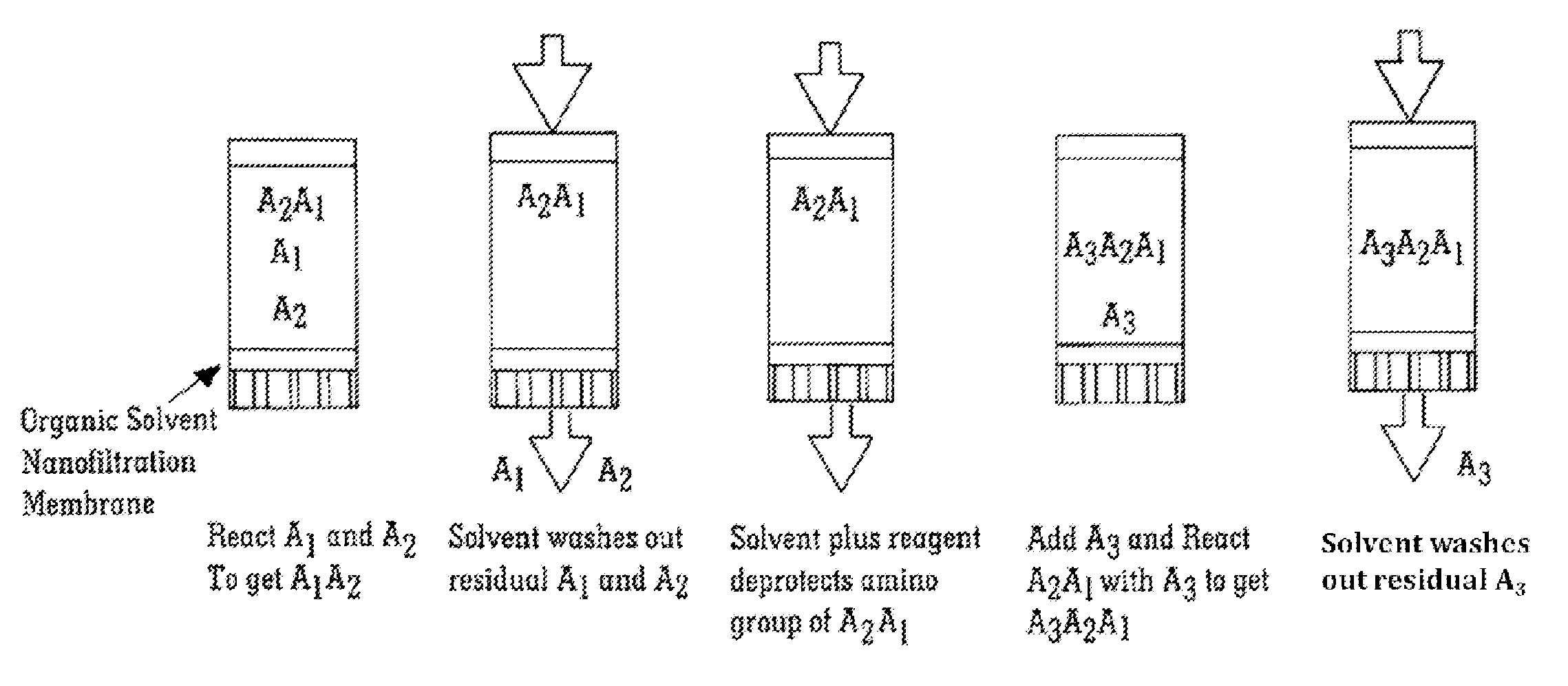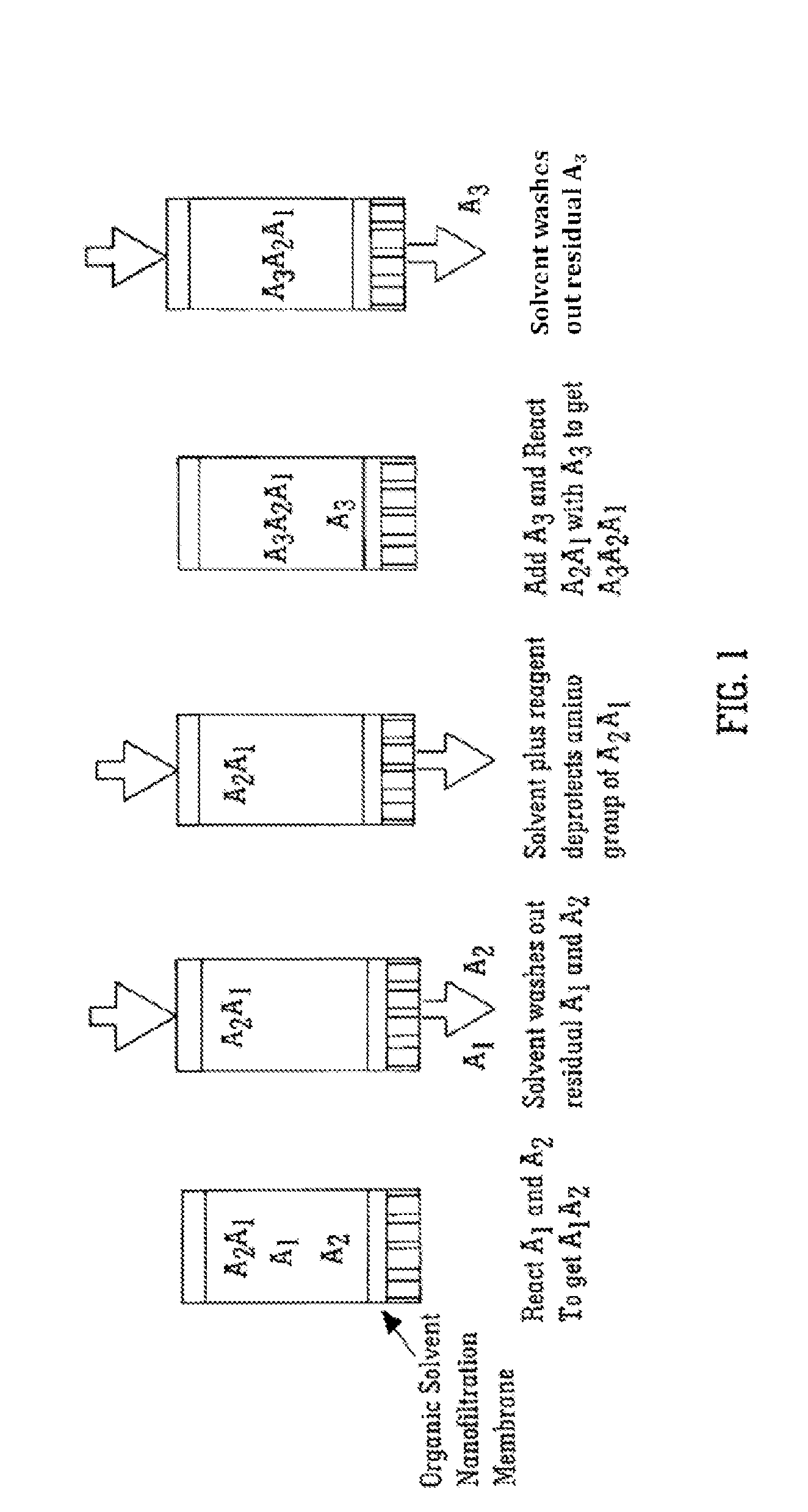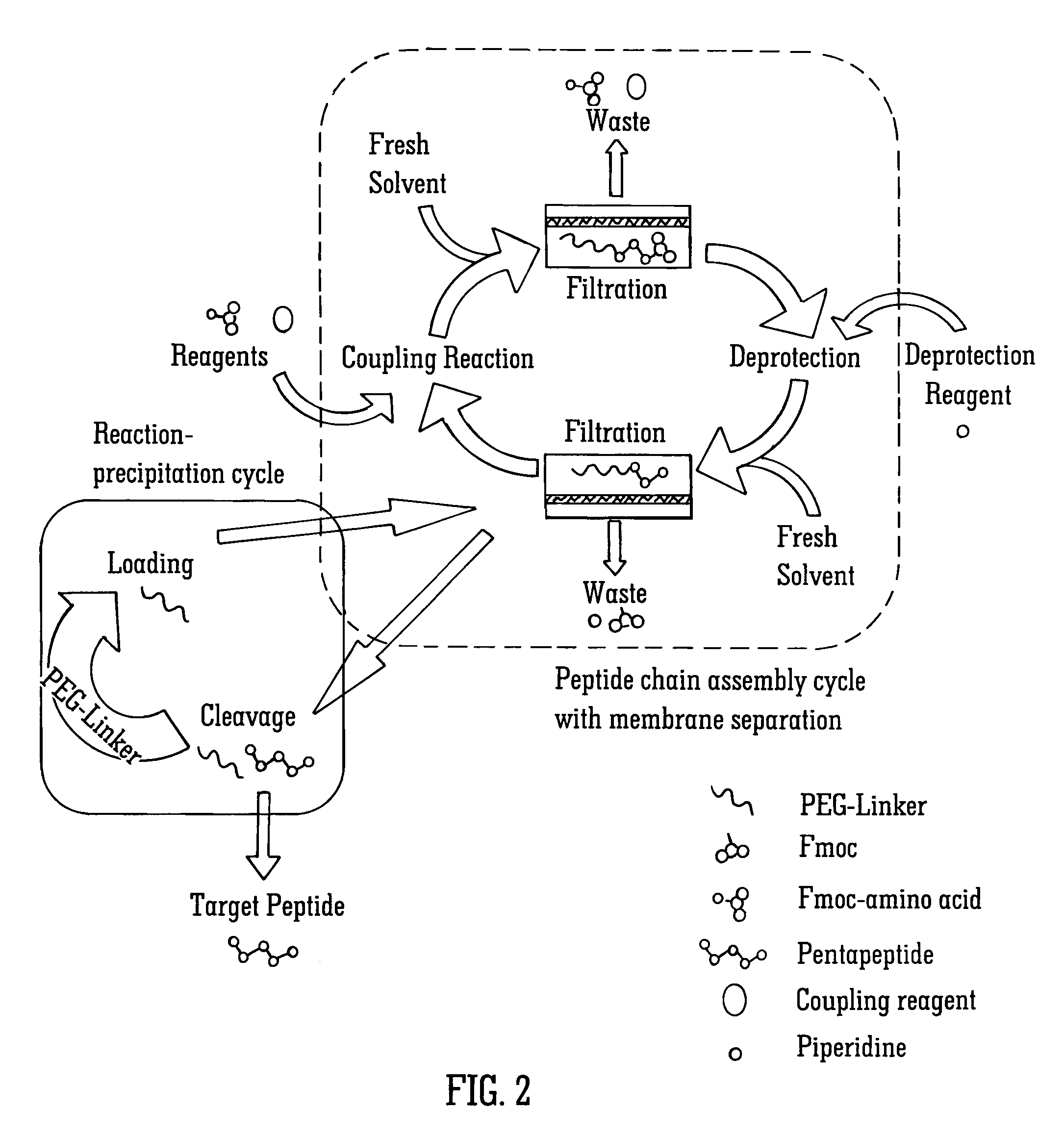Solvent resistant diafiltration of peptides, PNA or oligonucleotides
a technology of peptides and oligonucleotides, which is applied in the preparation of sugar derivatives, peptides, medical preparations, etc., can solve the problems of not being widely applied to the separation of solutes in organic solvents and the tedious nature of purification
- Summary
- Abstract
- Description
- Claims
- Application Information
AI Technical Summary
Benefits of technology
Problems solved by technology
Method used
Image
Examples
example 1
[0072]A model peptide with sequence Tyr-Ala-Tyr-Ala-Tyr (SEQ ID NO 1) was produced by membrane enhanced peptide synthesis (MEPS) using a polymeric membrane. The sequence was chosen in order to include one of the largest common protected amino acids Fmoc-Tyr(tBu) and one of the smallest protected hydrophobic amino acids, Fmoc-Ala. A chemically cross-linked polyimide membrane (DuraMem™, MET Ltd, UK believed to be made following techniques described in PCT / GB2007 / 050218) was used to perform the membrane separation steps. The rejection of the MeO-PEG-Inker-peptide was ˜100% for the coupling step and >99.7% for the deprotection step.
Methylated Amino Poly(ethylene glycol) (MeO-PEG-NH2) Synthesis
[0073]The procedure used to produce MeO-PEG-NH2 is illustrated in Scheme 1:
[0074]
[0075]MeO-PEG-Tosylate synthesis (1). 20 g of Polyethylene glycol monomethyl ether (MeO-PEG, MW-5000 gmol−1) was dehydrated in vacuo at 80° C. for 4 hours before dissolving in 100 ml of DCM (25 mL per mmol MeO-PEG). 36...
example 2
[0084]The model peptide sequence Tyr-Ala-Tyr-Ala-Tyr (SEQ ID NO 1) was produced again as an example of membrane enhanced peptide synthesis with a ceramic membrane. An Inopor zirconium oxide coated membrane with 3 nm pore size and hydrophobic surface modification (Inopor GmbH, Germany) was used in this example.
[0085]The membrane rejection of the MeO-PEG-peptide increased to >99.7% after the first and the second amino acid attachment and ˜100% for later attachments.
Methylated Amino Poly(ethylene glycol)(MeO-PEG-NH2) Synthesis
[0086]The MeO-PEG-NH2 used in this example was produced by the same route as described in Example 1.
Membrane Relection Results
[0087]Rejection data for this membrane are presented in Table 1. The Inopor membrane exhibited 99% rejection of both MeO-PEG and MeO-PEG-HMPA.
[0088]A number of Fmoc-amino acids were tested covering a wide range of properties—the lowest MW amino acid and the highest MW amino acid, acidic, basic and hydrophobic amino acids, and some of the am...
example 3
[0096]In this example the pentapeptide Thymopentin (H-Arg-Lys-Asp-Val-Tyr-OH) SEQ ID NO 2 was made with the both the Membrane Enhanced Peptide Synthesis (MEPS) process and for comparison using the Solid Phase Peptide Synthesis (SPPS) process.
Methylated Amino Poly(ethylene glycol)(MeO-PEG-NH2) Synthesis
[0097]The methylated amino poly(ethylene glycol) synthesized for this example was based on the procedure shown in Scheme 2.
[0098]
[0099]Attachment of Fmoc-Ala onto MeO-PEG (4). 10 g of MeO-PEG was dissolved in 20 ml of DCM (10 ml per mmol MeO-PEG), while 1.2 g of 0.54 g of Fmoc-Ala and HOBt (both 2 mol per mol MeO-PEG) were dissolved in 8 ml of DMF (4 ml per mmol MeO-PEG) before mixing the two solutions together. 0.25 g of DIC (2 mol per mol MeO-PEG) was afterward added and mixed vigorously for 2 hours at 4° C. Solid impurities were filtered and product was precipitated with diethyl ether and dried. The coupling step was repeated 3 times to obtain conversion >80%. MeO-PEG-Ala-Fmoc produ...
PUM
| Property | Measurement | Unit |
|---|---|---|
| molecular weight | aaaaa | aaaaa |
| MW | aaaaa | aaaaa |
| MW | aaaaa | aaaaa |
Abstract
Description
Claims
Application Information
 Login to View More
Login to View More - R&D
- Intellectual Property
- Life Sciences
- Materials
- Tech Scout
- Unparalleled Data Quality
- Higher Quality Content
- 60% Fewer Hallucinations
Browse by: Latest US Patents, China's latest patents, Technical Efficacy Thesaurus, Application Domain, Technology Topic, Popular Technical Reports.
© 2025 PatSnap. All rights reserved.Legal|Privacy policy|Modern Slavery Act Transparency Statement|Sitemap|About US| Contact US: help@patsnap.com



